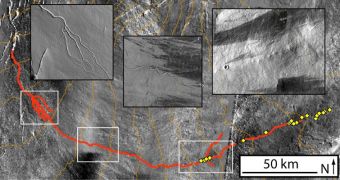Scientists speaking at the 41st Lunar and Planetary Science Conference said on March 4 that a large number of the channels resembling rivers that had been discovered on Mars appear to have been formed by volcanic lava flows. The idea was presented by Jacob Bleacher, the leader of a NASA Goddard Space Flight Center (GSFC) team that conducted a series of thorough investigations on the matter. The new idea is extremely important, as scientists have been debating whether these channels were caused by water or by lava for many years. The conclusions of these arguments will dictate the chances of future missions finding water on the Red Planet, NASA reports.
According to the GSFC team leader, lava flows explain at least one of the meandering channels on the surface of Mars. He argues that, at times, the actions of water and lava can be very similar, and that, given the long time that has passed since any of them has been active on the Red Planet, no one can blame anyone for not telling the two apart. “To understand if life, as we know it, ever existed on Mars, we need to understand where water is or was,” Bleacher reveals. Martian experts know that most of the existing water on the planet is located within underground ice deposits, as well as in the two ice caps at the poles. But some believe that water existed on the surface in a free form, maybe even as an ocean.
If this turns out to be true, then the likelihood of some forms of life having evolved on the Red Planet increases considerably. This is why Bleacher's work is so important. The expert and his group managed to determine that a number of features previously thought to have been carved out by water were actually made by lava. “But one thing I've learned is not to underestimate the way that liquid rock will flow. It really can produce a lot of things that we might not think it would,” the expert said. He added, however, that the new study is not meant to combat the idea that some of the channels on Mars may have been carved out by water. He explained that this was not true for the channels he surveyed.
“We found terraced walls on the insides of these channels, channels that go out and just disappear, channels that cut back into the main one, and vertical walls 9 meters (~29 feet) high. So, right here, in something that we know was formed only by flowing lava, we found most of the features that were considered to be diagnostic of water-carved channels on Mars,” Bleacher said. The conclusion of the new study “not only has implications for the geological evolution of the Ascraeus Mons but also the whole Tharsis Bulge [volcanic region]. It may also have some implications for the supposed widespread involvement of water in the geological evolution of Mars,” concluded coauthor Andy de Wet, who is an expert at the Lancaster, Pennsylvania-based Franklin & Marshall College.

 14 DAY TRIAL //
14 DAY TRIAL //